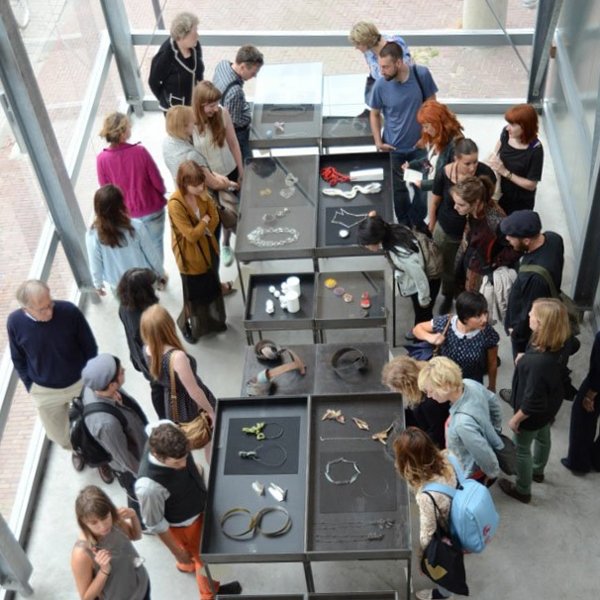
This unique event—incorporating the exhibition, the Marzee Graduate Prize* for the most promising students, a symposium for participants the day after the opening, and a small display of work by last year’s prizewinners—is a manifest demonstration of the passion and commitment Galerie Marzee’s director, Marie-José van den Hout, clearly feels toward supporting and promoting emerging young talent in innovative contemporary jewelry. “Jewelry is not the first necessity in life and especially not in times of crisis,” she says. “This show will give the young artists their first exhibition in a world-renowned gallery and will help launch their future careers.”
A Short History
Over the past 25 years or so, the Marzee Graduate Show has grown from a modest affair, exhibiting work by a handful of students from the Dutch schools (Gerrit Rietveld Academie in Amsterdam, Academie Beeldende Kunsten in Maastricht, and ArtEz Hogeschool voor de Kunsten in Arnhem), to an event unparalleled in size and scope. Since 1995, the show has broadened its outlook to include a slew of international schools. Indeed, this year it features work by 105 students from 39 schools in 22 different countries, including students from two schools participating for the first time—Indiana University and San Diego State University, both in the USA.
The process of selecting work for inclusion is a mixed affair. Van den Hout usually visits a number of the European schools’ graduation shows herself—in the Netherlands, Germany, Belgium, and Italy, as well as New Designers and the RCA in the UK—which gives her the opportunity to see the work firsthand and talk to the students. For others, there is a slightly more random aspect to the process as van den Hout is reliant upon photographs and the recommendations of tutors from schools invited to participate. “Making such decisions at one remove and without the physical presence of the work is incredibly difficult,” she admits. Conscious that mediating the decision in this way imposes additional layers of subjectivity on the selection process, van den Hout is exploring ways to somehow open up and streamline the procedure for next year’s exhibition.
Promoting the New Generation
That the Marzee Graduate Show is an honest reflection of the strongest work produced by international students is vital to its continuing success. No other gallery mounts an exhibition with these intentions: to endorse the work of a new generation of jewelry artists; to increase their exposure to the wider public; and to encourage a dialogue between makers and their wearers. Participants are well aware of the undeniable importance of this event for their careers. Speaking to a number of the graduates during the opening, it was clear that they were not only “delighted” and “honored” to have been selected, but that they had a keen sense of how pivotal the event might be for them. For many, particularly those living outside Europe, it presents an opportunity “to engage with the jewelry field outside of our small pocket of the world” and “to feel that you are a part of something bigger than your usual surroundings (and that) gives you a sense of connection.” Many see it as one of their first steps into the “business” of jewelry, recognizing the important role a gallery can play in introducing an artist to buyers. Exposure is key, “but exposure does not necessarily amount to sales, which is why establishing relationships with galleries is crucial for new makers.”

Pebbles, Pins, and Potatoes
The symposium, which takes place in the gallery on the day after the opening, provides the graduates a chance to present and discuss their work with their contemporaries from around the world. For van den Hout, this is “the most special part of the exhibition,” the chance for her to enjoy her “children,” and watch them share their thoughts and inspirations in an enquiring and unintimidating environment.
Before talking about their work, participants are invited to dress one of their colleagues in a piece of their jewelry, either selecting someone themselves or choosing from volunteers keen to wear something that has caught their eye. Seen in the context of the body, a new conversation begins, and this intimate moment speaks volumes, perhaps more so than the makers can themselves. As Dr. Susan Cohn put it in the introduction to her 2012 exhibition Unexpected Pleasures: The Art and Design of Contemporary Jewelry, “it can be serious or frivolous, experimental or ceremonial, tasteful or daring, but in all circumstances, jewelry will ‘talk’ for its wearer.” And so the jewelry spoke.
We watched pumice pebbles, hollowed and honed into brooches, migrate from the gallery floor to a woolly jumper as the maker Vivi Touloumidi, from Konstfack in Stockholm, asked, “what do I want from jewelry?” This rhetorical question forms the backbone of her ongoing enquiry into the position of jewelry in life. She wants to know, “Can jewelry contribute to social change? Can one protest by wearing jewelry?” Touloumidi may not have the answers yet, but she remains convinced that her jewelry should convey meaning.
Another participant reeled under the 7-kg weight of Izzy Parker’s (RCA, London) Tactile Treatment body piece, comprised of 11,570 acupuncture needles. Exploring points of physical contact, this provocative piece invites a dialogue, at once asking to be touched whilst presenting itself as something potentially harmful. Ripples of laughter and recognition accompanied Elin Flognman’s (HDK Högskolan för Design och Konsthantverk, Gothenburg) presentation of her “potatoes” necklace as she talked about allowing herself to experience the mystery behind the boredom in the making process, to see the jewel of something special that glistens in the repetition.
Common Threads
The exhibition roams alphabetically around the world, with work displayed on black-lined tables across three floors of the gallery and 40 of the larger neckpieces hung against a white wall on the first floor. Walking around the exhibition, the fact that young jewelers continue to occupy a world “in which ideas and themes rather than national cultures provide the common threads” (Peter Dormer and Ralph Turner) is evident. What strikes me most are the similarities; the striving to articulate a vocabulary of form and material where process is key, a reverence for nature, a desire to negotiate the connections between mankind and the world we have created around us. This is not, perhaps, surprising in this digital age where our reference points are shared.
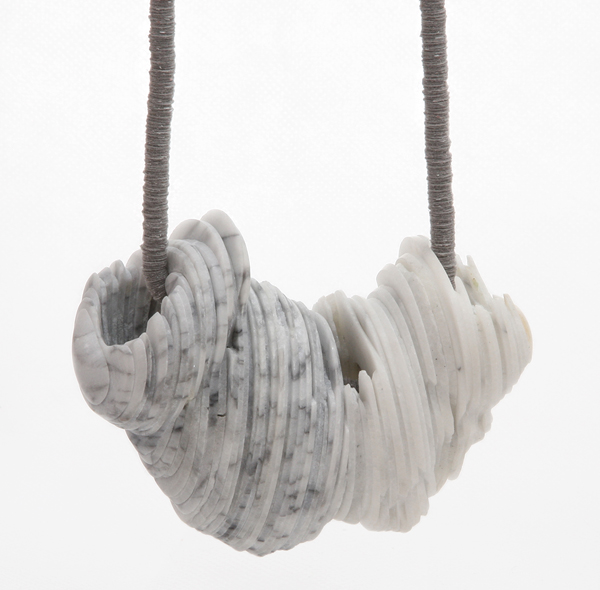
The relationship between the natural and the readymade is investigated in Tarja Tuupanen’s MA work from Konstfack, Stockholm. In the past, she has displayed a passion and empathy for natural stone, but here, in Notions of Skill, Tuupanen challenges her affinity with her materials by turning to mass-produced, off-the-shelf marble tableware, salt and pepper shakers, and tacky candleholders from the 1980s. The objects are sliced and re-formed into brooches and neckpieces that bring to mind glacial formations. Intrigued by how a shift away from something raw and natural might alter her preconceived notions of material value and the way she uses her stone-working skills, Tuupanen focuses on the minutiae, creating an unexpectedly elegant chain from the velour pad used to cushion a tabletop from the rough underside of these tableware pieces.
The tendency towards appropriating quotidian objects is notable amongst this year’s graduates. For some, perhaps, it is universal shorthand for familiar memory and association. Annie Gobel of RMIT in Melbourne splices plastic toys with wood and resin whilst Akane Yamazaki from Tokyo’s Hiko Mizuno College of Jewelry creates a weighty neckpiece, ABCDESK!, carved from her old desk. Spidery doodles and an accumulation of youthful graffiti dance across its polished wooden, lemon-like segments. Jing He (Gerrit Rietveld Academie in Amsterdam) attempts to bring an aesthetic quality to otherwise purely functional objects, such as bottle openers and egg whisks. Artfully constructed, these pieces rely entirely upon their constituent parts in their assemblage as brooches—a single loop from a whisk is released to create a brooch pin, for example. These various strategies for manipulating found objects are evident across the creative fields. There were Duchamp’s “readymades,” Kurt Schwitters’s Merzbau, and more recently the sculptural work of Bill Woodrow. Jewelers such as Hans Stofer, Laura Potter, and Lisa Walker all make use of the debris of daily life, making no attempt to disguise the origins of the items they work with.
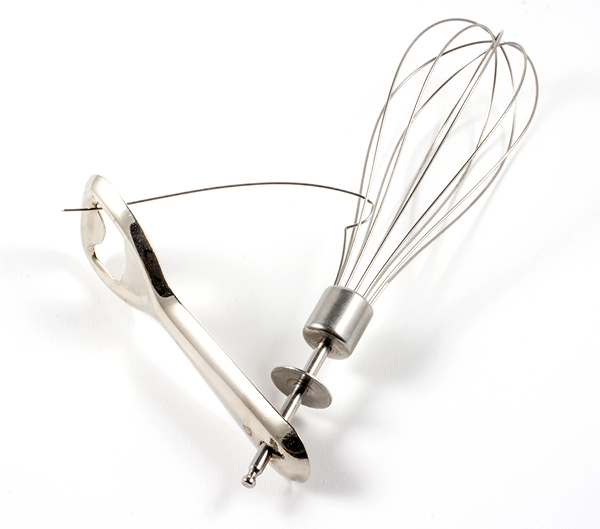
Kitchen paraphernalia appears once again in the thoughtful and thought-provoking work of Benita Gikaite, a graduate from Central St Martins in London. Born in Lithuania, Gikaite looked back to the period of Soviet occupation, creating a collection that celebrates the creativity and ingenuity employed by people in times of hardship. In her hands, wooden spoons, rolling pins, pasta, and seeds metamorphose from commonplace household items into something rather special, as does her oak chopping board collar, comprising 850 meticulously hand-carved chain mail links.
San Diego State University graduate Alexandra Hopp’s series Obsessive Compulsive: (dis) Order simply and persuasively expresses the preoccupation with material and the repetitive, often laborious practice of the goldsmith. For Three Collars about Alignment, Hopp has painstakingly arranged and soldered more than 2000 commercially produced silver earring posts with their .925 stamps aligned. In Trichotillomaniac’s Inner Monologue Chain, each link varies slightly in size and shape and represents a letter of the alphabet or a punctuation mark. I challenge any visitor to read the ramblings written into this 50-feet-long necklace. Each of Hopp’s pieces is a perfectly realized manifestation of what she sees as a perceptible correlation between the art and craft of the jeweler and the daily habits of someone living with obsessive/compulsive disorder (OCD), the “repeated, ritualized” actions and the shared absorption in minor details so often overlooked by the casual viewer.
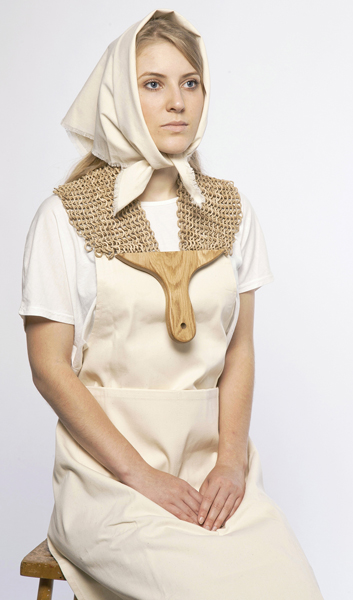
To highlight the similarities, both in terms of theme as well as material choices of this year’s graduates—an eschewing of the precious in favor of the found, the man-made, and the organic—is not to undermine their achievements. For many, the national borders no longer represent limitations, and students will willingly relocate to study in a chosen city with a particular teacher. To some extent, increased mobility fosters stylistic and thematic homogeneity, but whilst motivations may converge, personal resonances remain just that— personal. And so we have the myriad manifestations of these common preoccupations represented in the show.
There are, of course, exceptions, graduates whose work looks elsewhere: the private worlds of Charlotte Maslow’s (HDK, Gothenburg) enigmatic enameled portraits; the hip-hop aesthetic of Annekathrin Pohle’s (Burg Giebichenstein Kunsthochschule, Halle) concrete rings; and the beguilingly quiet and graceful necklaces exquisitely rendered in aluminum foil by Barbara Schrobenhauser, a graduate from Akademie der Bildenden Künste in Munich.
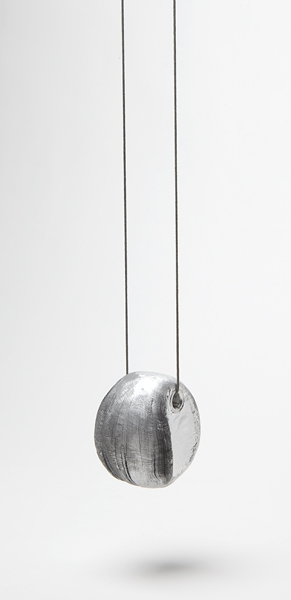
Galerie Marzee sets the bar high with this show, and there is certainly some excellent and beautifully crafted jewelry to be seen, but I was left craving a little more daring, something to confound my expectations. The work on display exemplifies the weaving of common ideas across the wider geographical terrain that contemporary jewelry now occupies, but I would have welcomed the chance to see more of these newly graduated students seize the opportunity afforded by study to push a little harder at the boundaries of form, material, and construction.
Is this show largely representative of the work produced by up-and-coming artists from jewelry schools around the world? Probably. But there are some significant regions noticeable in their absence. For starters, there is no representation from the vibrant jewelry communities in Central and South America, mainly a result of the limitations of the current selection process. That said, Marzee’s show continues to afford us the only opportunity to see international graduate work on one platform, and I hope it will continue to grow and support an ever wider geographic cross-section of burgeoning talent.
* The Marzee Graduate prize, a weeklong workshop at Atelier Ravery in Belgium, was awarded to Carmen Hauser and Levan Jishkariani (Fachhochschule Trier), Barbara Schrobenhauser (Akademie der Bildenden Künste, Munich), Benita Gikaite (Central St Martins, London), Mallory Weston (Rhode Island School of Design, Providence), Alexandra Hopp, and Amanda Packer (San Diego State University)




